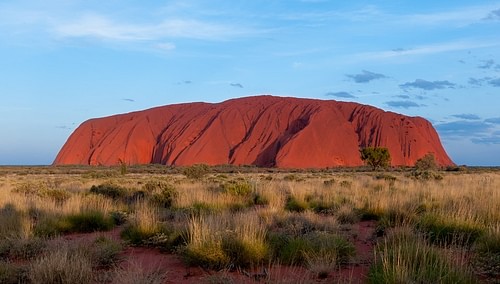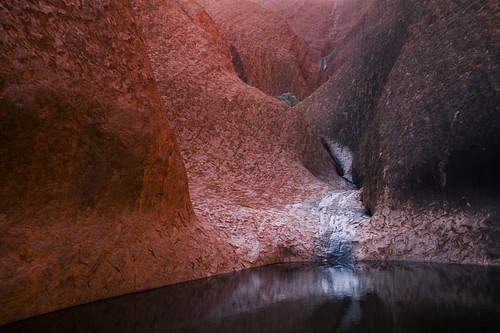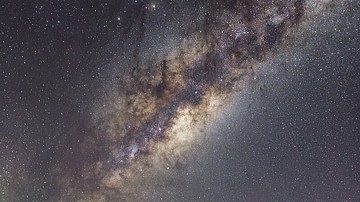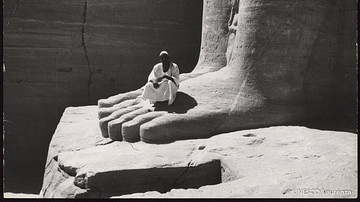
Uluru (also known as Ayers Rock and pronounced: ool-or-roo) is a large natural sandstone rock formation located in the Northern Territory of Australia. It stands at a massive 348 meters tall and measures a lengthy 9.4 km in width. The sandstone that makes up Uluru is estimated to be around 600 million years old. Uluru is a sacred site to the Anangu tribes of Central Australia, the indigenous peoples of the Western Desert. Although it was 'found' by William Gosse working under the South Australian Government in 1873 CE, the Anangu people lived and inhabited the area for more than 30,000 years and still remain to this day. The name 'Ayers Rock' was given by Gosse in honour of the South Australian Premier at the time, Sir Henry Ayers. Uluru is home to many ancient petroglyphs and rock paintings. For the locals, including the Pitjantjatjara and Yankunytjatjara (both are indigenous language groups), the site also holds sacred traditions, culture, and rich history. Uluru, along with the surrounding Uluru-Kata Tjuta National Park, is listed as a UNESCO World Heritage site.
SIGNIFICANCE
The religious and cultural traditions that the Anangu people practice are known as Tjukurpa. It has a multitude of meaning, but primarily symbolises the Anangu way of life and religious culture. Many of these Tjukurpa stories, songs, ceremonies, and dances focus on the creation of Uluru as well as the animals, people, and wildlife around the area. Furthermore, the importance of Uluru can be highlighted through its inseparable connection to Tjukurpa, or traditional law. The Anangu consider themselves linked to the traditional creator spirits of the land and believe they are directly descended from them, designated to protect and maintain the ancestral lands they inhabit. Because of this, Uluru remains an extremely sacred and protective site to the Anangu people. Uluru and the people who inhabit the area hold a plethora of ancient tradition, knowledge, wisdom, stories, songs, ceremonies, and history, which have been passed on from generation to generation, just as they have been for thousands of years. All the way from the original hunter-gatherers of ancient Uluru to the present day Anangu, these ancient traditions and religion are vastly important to the Anangu way of life and society.
ROCK ART & PETROGLYPHS
Anangu rock paintings are made from a combination of natural minerals such as red and yellow ochre, iron-stained clays, desert oak, charcoal, and white ash. This rock art is found all around Uluru and the surrounding park area. These paintings and petroglyphs tie directly in the Anangu Tjukurpa culture. They are used for religious purposes by depicting creation stories and legends, similar to how other religions use scripture or written language to convey their ideas and philosophy. The Anangu ensure their tradition is passed on by using these rock artworks to teach both members and non-members of the tribe about their spiritual Dreamtime stories.
Unlike some other ancient histories and traditions, the ancient Anangu culture still survives and thrives to this day. Unfortunately, due to the sacred nature of the sites, and their belief that "knowledge is earned" (Uluru-Kata Tjuta National Park Visitor's Guide, 29), photography of a large portion of these ancient rock paintings and petroglyphs is forbidden by the Anangu.
NOTABLE LOCATIONS
Below is a short list of some significant, religious or sacred locations that would be used for ceremonies, teaching, and other activities related to the indigenous people at Uluru. At culturally sensitive sites no photography or filming is allowed.
- Mutitjulu Waterhole - A permanent ancient water spring overlooked by cliffs and waterfalls on the south side of Uluru. It provides a natural source of water to flora and fauna in the area. Home to many diverse animals and plant species.
- Kulpi Mutitjulu (Mutitjulu Cave) - Used by ancient tribes to share and distribute food caught during the day. Also used for teaching children Dreamtime stories as there are many paintings in the cave. The various symbols and depictions inside "can represent a waterhole, campsite or a place of significance" (Parks Australia website, Kulpi Mutitjulu).
- Taputji (culturally sensitive site) - Separate from Uluru on the northeast side near Kuniya Piti, Taputji was an ancient hunter-gatherer location used for collecting food and plants to make food for the inhabitants.
- Tjukatjapi, Pulari, and Mala Puta (culturally sensitive sites) - Located on the north, northwest, and south sides respectively, they are sacred women's sites. The rock carvings and features are extremely sensitive to the Anangu women and are the equivalent of religious texts in other cultures/religions.
- Kantju Gorge - Similar to the Mutitjulu Waterhole, Kantju Gorge is an Ancient waterfall and spring overlooked by cliffs. Located between Mala Puta and Warayuki on the north/north-west side of Uluru, it provides water for plenty of plants and animals in the area.
- Warayuki (culturally sensitive site) - Warayuki is a cave-like sacred men's site located next to Tjukatjapi on the north side of Uluru. It is a sacred site to Anangu men and retains great religious significance.
- Kuniya Piti (culturally sensitive site) - Sacred men's site with similar sacred rock carvings and features to Mala Puta and Pulari. Located on the far east side of Uluru, near Taputji, it also retains similar significance to the indigenous peoples.
ULURU Today
Following the restoration of ownership of Uluru back to the Pitjantjatjara people in 1985 CE, Uluru has been jointly managed by both the National Parks and Wildlife Agency of Australia and the native peoples of the area. Uluru is an extremely rich and engaging historical location to visit, and the elders of the land often take famous or important visitors (such as world leaders) to the Mutitjulu Waterhole. The Anangu themselves do not climb Uluru and, although not strictly forbidden, request that visitors refrain from climbing due to its extremely sacred nature and historical significance. Not only does it hold the memories and traditions of ancient Australians but it is still taught and passed on by the Anangu people to this day. As archaeologist R.G. Gunn put it,
Much of the rock art of central Australia still retains a real significance for its Custodians - a significance that must be acknowledged by both site developers and researchers alike. (Gunn, 125)





